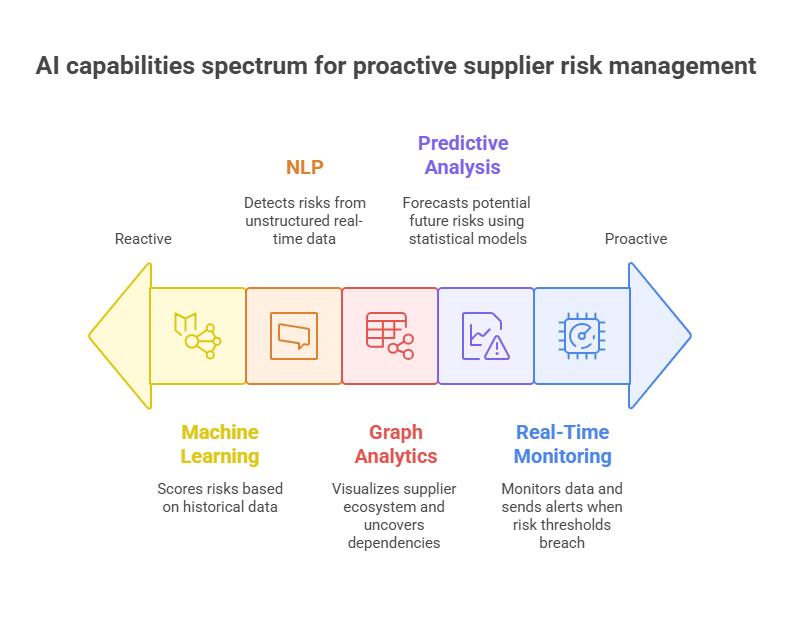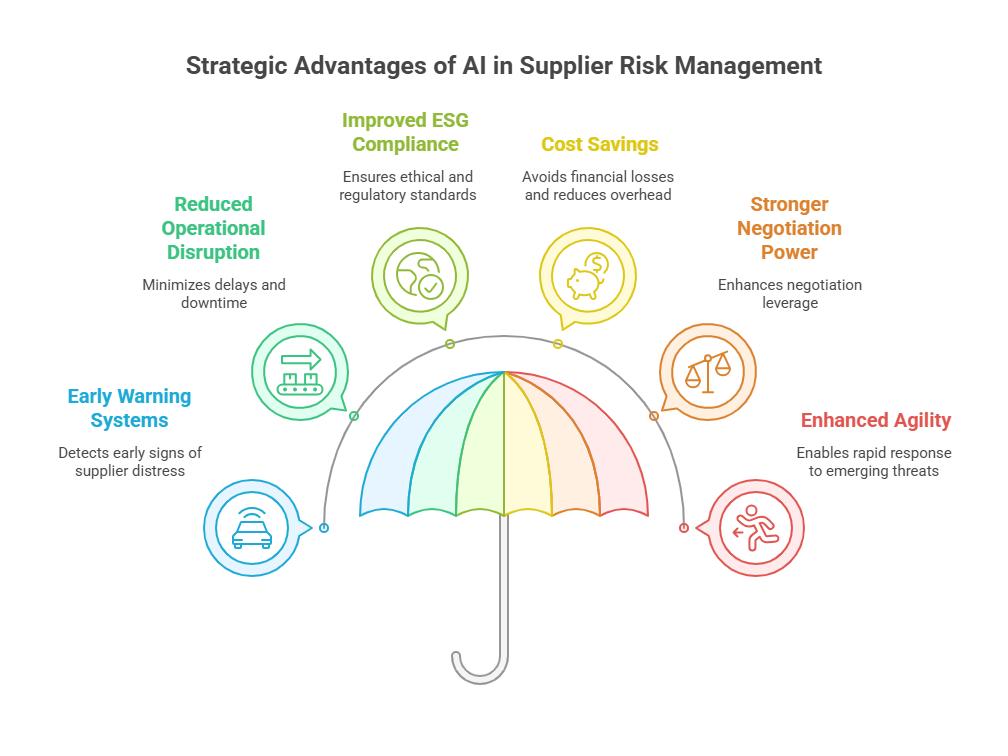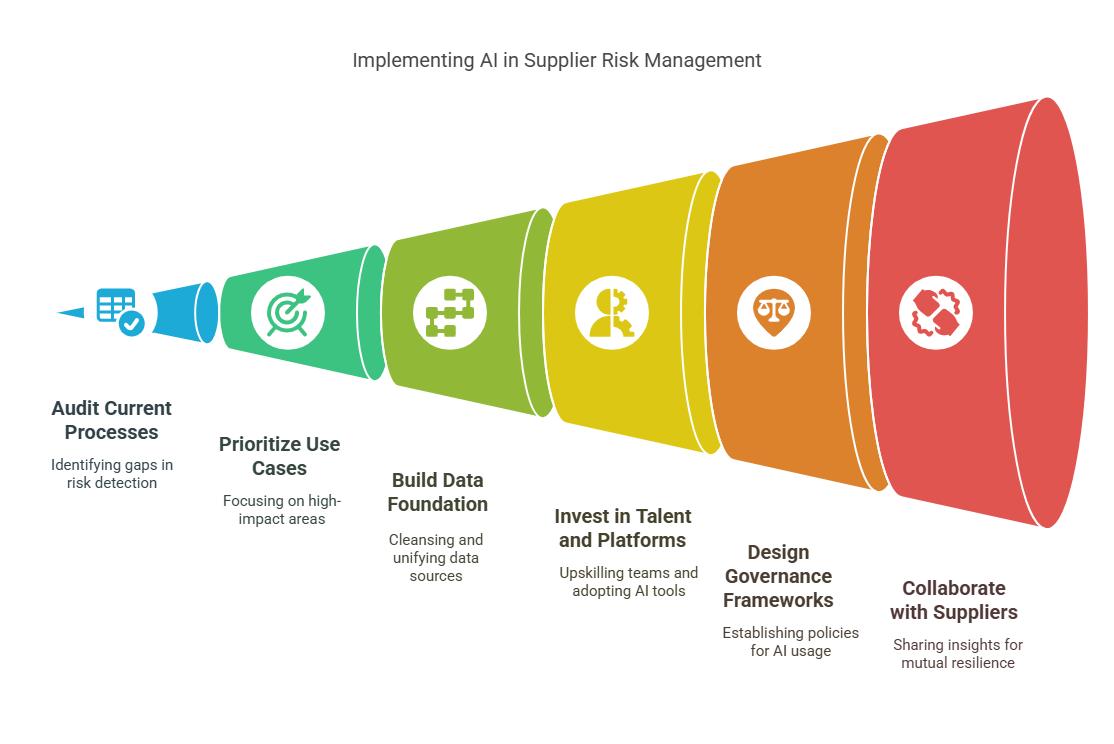AI in Procurement: Detecting Supplier Risks Before They Impact Operations
How Strategic Procurement Leaders Use Artificial Intelligence to Build Supply Chain Resilience and Gain Predictive Visibility
The procurement function has rapidly evolved from a transactional service to a core strategic enabler of business continuity and competitive advantage Yet, as global supply chains grow increasingly fragile, procurement teams are exposed to unprecedented supplier-related risk, financial, geopolitical, environmental, operational, and reputational
Artificial Intelligence (AI) is redefining how organizations detect, assess, and mitigate supplier risks With real-time monitoring, predictive analytics, and cognitive insights, AI empowers procurement leaders to move from reactive issue management to proactive risk prevention
This blog outlines how AI transforms supplier risk detection and prevention It provides a comprehensive view of applications, use cases, organizational readiness factors, and future trajectories, all designed to guide procurement leaders, CIOs, and supply chain executives in embedding AI into the procurement ecosystem
Introduction
Global disruptions over the last five years, from the COVID-19 pandemic to regional wars, inflation shocks, ESG violations, and cybersecurity breaches, have exposed how deeply supplier risks can impact enterprise performance Gartner surveys indicate that 71% of Chief Procurement Officers (CPOs) now prioritize risk mitigation and supplier resilience as top strategic imperatives
Today’s procurement leaders are responsible for sourcing cost-effectively and also ensuring the continuity, ethical compliance, and security of supplier networks
As the scale and complexity of risk multiply, manual risk monitoring tools have become insufficient Artificial Intelligence, a set of technologies capable of detecting signals across fragmented data, identifying hidden threats, and providing timely, actionable insights
Why Traditional Supplier Risk Management Falls Short
Conventional supplier risk management frameworks are typically structured around static risk categories (e g , financial health, delivery delays, compliance audits) However, these systems suffer from several systemic limitations:
Traditional Approach
Periodic audits and questionnaires
Manual reviews and scorecards
Tier-1 supplier focus
Fragmented data sources
Siloed business functions
Key Limitation
Stale data; fails to detect evolving threats
Resource-intensive and inconsistent
Neglects multi-tier supply chain vulnerabilities
Inability to synthesize early warning signals
Risk decisions isolated from operational realities
A significant challenge lies in the latency between when a supplier issue arises and when it’s detected For example, by the time a supplier’s financial weakness is discovered via quarterly review, the damage from missed deliveries or breach of contract may already be underway
AI provides a paradigm shift from lagging to leading indicators, from periodic to continuous insight, and from anecdotal to data-driven decision-making
The Strategic Role of AI in Procurement
AI’s application in procurement is a strategic capability that enhances enterprise agility, governance, and resilience
Four Strategic Shifts AI Enables in Procurement
From Reactive to Predictive
Move from firefighting supplier issues to forecasting them in advance
From Gut Feel to Data-Driven
Replace subjective risk ratings with algorithmic scoring based on real-time data
From Tier-1 to Ecosystem Visibility
Expand monitoring to tier-2, tier-3, and subcontracted entities
Enable sourcing based on risk-adjusted total value, not just price and performance
According to a 2024 Gartner CIO survey, organizations that embed AI in procurement reduce supplier risk exposure by 45% on average and recover from disruptions 30% faster than peers
AI Capabilities for Supplier Risk Detection
As supplier networks become more global and interdependent, procurement leaders are turning to artificial intelligence (AI) to transform how supplier risks are identified, assessed, and mitigated AI provides a multidimensional approach to risk management, synthesizing structured and unstructured data from across the enterprise and beyond The following five core AI capabilities are foundational to enabling real-time, predictive supplier risk detection:

Machine Learning (ML)-Based Risk Scoring
Machine learning algorithms process historical supplier performance data, procurement records, incident logs, and risk outcomes to build adaptive risk models
These models identify patterns that correlate with past disruptions, such as late deliveries, financial stress, or quality failures, and assign risk scores to current suppliers based on similar traits Over time, the system continuously learns from new data, refining its predictions and increasing accuracy
For example, if certain payment delays historically precede insolvency, the model will flag similar behavior as a predictive warning signal ML allows for nuanced, context-aware scoring that evolves alongside market dynamics and internal business shifts
Natural Language Processing (NLP)
NLP enables AI systems to ingest and interpret vast volumes of unstructured data, ranging from global news articles and social media posts to legal disclosures, regulatory updates, and NGO reports This capability is particularly valuable for identifying reputational, ethical, and geopolitical risks
For instance, NLP can detect early signs of ESG violations, lawsuits, or labor strikes involving a supplier, even if those issues haven’t yet reached formal reporting channels It then translates these signals into structured risk indicators that procurement systems can act upon
NLP broadens visibility beyond the confines of internal data, capturing sentiment and developments in real time
Predictive Analytics
Beyond detecting current issues, predictive analytics uses statistical and econometric models to forecast potential future risks across dimensions such as financial health, operational continuity, and compliance
These models incorporate leading indicators like macroeconomic trends, inflation rates, regional instability, and environmental changes to simulate disruption scenarios
For instance, predictive analytics can quantify the probability of shipment delays due to upcoming monsoons in a supplier’s region or rising input costs that could affect delivery schedules These foresights empower procurement teams to build contingency plans before risks materialize
Cognitive Search and Graph Analytics
This capability allows procurement teams to go beyond linear supplier relationships and visualize the extended supplier ecosystem using dynamic network graphs By mapping connections between suppliers, subcontractors, manufacturing sites, logistics partners, and geographic clusters, AI uncovers hidden dependencies and systemic vulnerabilities
For example, if multiple Tier-1 vendors rely on a common Tier-3 raw material supplier, disruptions at that node can have cascading effects Graph analytics helps detect these critical chokepoints and supports holistic risk mitigation planning across the value chain
Real-Time Monitoring and Alerts
AI-powered systems constantly monitor a combination of internal procurement data and external signals, such as shipment tracking, commodity prices, weather alerts, and geopolitical news, to detect anomalies
When risk thresholds are breached, the system sends real-time alerts to procurement and operations teams These alerts are contextual, actionable, and prioritized based on severity and potential impact
For example, a predictive AI model may flag a Tier-2 component supplier in Taiwan for a likely disruption due to upcoming regional elections and anticipated power grid instability With this early warning, the procurement team can initiate alternate sourcing or increase safety stock levels
Maturity Model for AI Supplier Risk Management
The adoption of AI in supplier risk management follows a clear maturity curve, reflecting an organization’s progression from manual, reactive practices to autonomous, AI decision-making This model helps procurement leaders benchmark their current capabilities and chart a strategic roadmap toward advanced resilience
Level 1 – Foundational
Organizations at this stage rely heavily on manual processes and static spreadsheets to assess supplier risk Evaluations are typically qualitative and limited to Tier-1 suppliers There is little to no real-time visibility, and responses to disruption are reactive rather than proactive Risk remains siloed within procurement with minimal cross-departmental coordination
Level 2 – Enabled
Risk management becomes more digitized, with supplier data housed in ERPs or procurement suites Dashboards provide visibility into key supplier KPIs, and early NLP tools may monitor for basic red flags However, analysis remains largely descriptive, with little automation or forward-looking insight Most large enterprises today operate within this stage
Level 3 – Intelligent
AI technologies begin to take root Machine learning models produce dynamic risk scores, predictive analytics forecast potential disruptions, and real-time alerts enhance responsiveness Organizations start shifting from hindsight to foresight, enabling faster, data-informed mitigation
Level 4 – Integrated
At this level, AI capabilities are embedded across finance, legal, logistics, and compliance, creating a unified view of supplier risk Decision-making becomes partially automated, with scenario modeling and advanced simulations informing procurement strategy
Level 5 – Autonomous
The most advanced stage features AI systems that autonomously execute mitigation plans, rerouting logistics, reassigning orders, or sourcing alternative suppliers without human intervention Dynamic risk resilience becomes a competitive advantage, observed in trailblazing sectors like aerospace, pharma, and high-tech
Maturity Stage Key Characteristics
Level 1 – Foundational
Level 2 – Enabled
Level 3 – Intelligent
Level 4 – Integrated
Level 5 – Autonomous
Manual risk assessments, Excel-based scoring, limited to Tier-1 suppliers
ERP integration, basic dashboards, and early NLP tools
ML-based risk scoring, real-time risk alerts, predictive insights
Cross-functional data integration (finance, legal, logistics), automated decision-making
AI-led risk mitigation actions (e g , auto-sourcing alternate suppliers), and dynamic resilience planning
Most organizations today operate at Level 2 or 3, with pioneers in aerospace, pharmaceuticals, and high-tech industries pushing into Level 4
Key Benefits of AI-Powered Supplier Risk Mitigation

The integration of AI into supplier risk management delivers tangible value across procurement, operations, compliance, and finance By shifting from reactive damage control to proactive mitigation, organizations can protect business continuity while improving cost efficiency and resilience Below are six key benefits that define the strategic advantage of AI-powered supplier risk mitigation:
Early Warning Systems
AI excels at detecting subtle signals of supplier distress, long before traditional methods might raise concern Through predictive modeling and real-time data analysis, AI systems can identify early indicators such as payment delays, workforce instability, regulatory scrutiny, or reputational damage
For example, a sudden drop in shipment frequency or negative ESG-related news could trigger automated alerts well in advance of a formal supplier failure, allowing stakeholders to respond proactively
Reduced Operational Disruption
Timely intervention is key to maintaining operational flow With AI-generated alerts, procurement teams can initiate alternative sourcing strategies, adjust inventory levels, or reroute logistics before a disruption escalates This capability minimizes delays, reduces downtime, and safeguards production schedules, especially in industries where even a short supply chain interruption can translate into significant financial loss
Improved ESG Compliance
Environmental, Social, and Governance (ESG) standards are under growing scrutiny AI tools equipped with natural language processing continuously monitor global news, NGO reports, and regulatory databases for ESG violations or ethical lapses among suppliers
This ensures compliance is upheld across all tiers of the supply chain, and organizations can quickly disengage from high-risk or non-compliant vendors
Cost Savings
Preventing disruptions is significantly more cost-effective than reacting to them AI helps companies avoid financial losses associated with expedited freight, SLA violations, production halts, and emergency vendor onboarding
Additionally, automated risk monitoring reduces the manual effort required for risk audits and performance reviews, lowering administrative overhead
Stronger Negotiation Power
When procurement has access to transparent, data-driven risk profiles, supplier negotiations shift in their favor AI insights offer leverage to negotiate better terms, demand contingency planning from suppliers, or justify supplier diversification strategies
Enhanced Agility
In volatile geopolitical or environmental conditions, real-time visibility is critical AI enables rapid scenario planning and decision-making, ensuring procurement teams can pivot swiftly in response to emerging threats, whether it’s a trade embargo, cyberattack, or pandemic outbreak
Benefit
Early Warning Systems
Reduced Operational Disruption
Improved ESG Compliance
Description
AI detects signs of supplier failure before traditional methods
Proactive alerts lead to timely intervention (e g , alternate sourcing, inventory adjustment)
Automated monitoring ensures supplier adherence to sustainability standards
Cost Savings Prevention of disruption-related penalties, expedited shipping costs, and missed SLAs
Stronger Negotiation Power
Enhanced Agility
Organizational and Technical Considerations
Transparency into supplier risk strengthens procurement strategy
Real-time data enables faster response to geopolitical, environmental, or market changes
Adopting AI for supplier risk requires a strategic approach encompassing people, processes, and platforms
Organizational Readiness
● Data Governance: Clean, accessible, and structured data is foundational
● Cross-Functional Alignment: Involve risk, finance, ESG, logistics, and IT teams
● Leadership Buy-In: Executive sponsorship is critical for change management
Technology Enablement
● Tool Integration: Ensure compatibility with ERPs, SRM tools, and contract management platforms
● Cloud Infrastructure: Use scalable cloud-based AI services for processing large datasets
● Third-Party Providers: Partner with AI firms specializing in procurement intelligence
Ethical and Regulatory Considerations
● Avoid algorithmic bias in supplier scoring
● Ensure compliance with data privacy and transparency standards (e g , GDPR, CCPA)
Gartner predicts that by 2027, over 50% of procurement organizations will integrate AI-based supplier risk intelligence into sourcing and contract decisions
Strategic Recommendations for Operationalizing AI in Supplier Risk Management
Adopting AI for supplier risk management requires more than just deploying new technology It demands a strategic, enterprise-wide shift in mindset, data governance, and organizational capabilities

For procurement leaders and CIOs seeking to embed AI into risk mitigation workflows, the following recommendations provide a practical blueprint to accelerate value realization and de-risk AI adoption:
Audit Your Current Risk Detection Process
Begin with a comprehensive assessment of your existing risk management practices Identify gaps in data visibility, response time, and risk scope across all supplier tiers
Are your current assessments manual, reactive, or siloed within departments? Do you lack real-time alerts, or are you overlooking key risk domains like reputational and geopolitical threats?
This audit sets the baseline and clarifies the critical areas AI must enhance, such as enabling predictive alerts, cross-tier visibility, and dynamic scenario modeling
Prioritize Use Cases with High Impact
To ensure early wins and stakeholder buy-in, prioritize AI use cases that deliver measurable impact Focus first on high-risk, high-cost domains like financial risk detection, shipment or lead-time variability, and ESG compliance monitoring These areas typically have abundant data, strong regulatory implications, and a direct influence on supply continuity and cost
Align these use cases with strategic business goals to demonstrate quick ROI and justify further investment
Build a Data-First Foundation
AI’s effectiveness hinges on high-quality data Begin by cleansing, unifying, and enriching your supplier, contract, and performance data Connect disparate data sources, including ERP systems, SRM tools, logistics platforms, and third-party risk databases, into a unified data lake or AI-ready warehouse The richer and cleaner the data, the more accurate and actionable your AI-driven insights will be
Invest in AI Talent and Platforms
Upskilling procurement professionals to interpret AI outputs is critical Equip teams with training in data literacy, risk modeling, and AI tool usage
Concurrently, evaluate and adopt AI-native platforms that offer modular integration, pre-trained models, and strong interoperability with your procurement tech stack Consider tools with built-in NLP, graph analytics, and alerting engines to accelerate deployment
Design Governance Frameworks
Operationalize AI by creating clear governance policies Define acceptable risk thresholds, escalation paths, decision-making authority, and ethical AI usage principles Ensure transparency, accountability, and traceability of AI-generated decisions, especially when automating mitigation actions or influencing vendor relationships
Collaborate with Strategic Suppliers
Treat AI risk management as a collaborative advantage rather than a compliance mechanism Share relevant AI insights with strategic suppliers to jointly assess vulnerabilities and co-create resilience plans This fosters trust, aligns incentives, and ensures mutual preparedness in facing disruption scenarios
Final Thoughts
AI is the linchpin of a next-generation supplier risk management strategy By adopting AI insights, procurement organizations can anticipate disruptions, protect revenue streams, and unlock competitive agility
The future of procurement belongs to those who can see risk before it hits With AI, that future is already here
